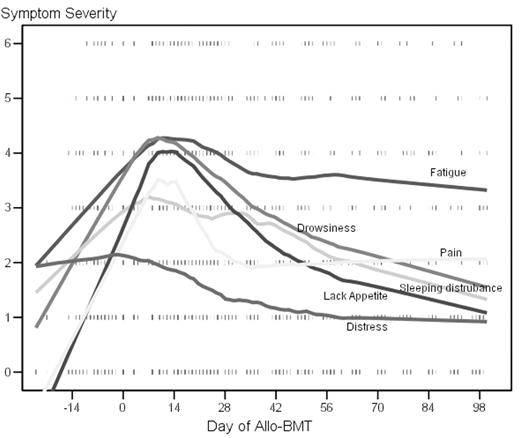Abstract
BMT patients develop multiple symptoms At nadir after transplantation that include pain, fatigue, poor appetite, and disturbed sleep. Animal models of sickness behavior suggest such symptoms may be related to increases in inflammatory cytokines. The objective of this study was to prospectively assess the relationship between symptom severity and changes in inflammatory cytokines.
Methods: Weekly symptom assessment with the M. D. Anderson Symptom Inventory was done for 30 AML/MDS patients during the first 100 days of Allo-BMT. A panel of inflammatory cytokines (IL-1ra, IL-6, IL-8, IL-10, IL-12, TNF-a) was assayed at several time points: pre BMT, conditioning, BMT day, BMT Day1, nadir, BMT day14, 21, 28, 60, 90–100.
Results: Multiple symptoms peaked at nadir, with some symptoms (fatigue and pain) remaining at high levels after nadir. Figure 1 shows the Lowess curves for selected symptoms on MDASI. Physical symptoms had much larger fluctuation than affective symptoms during the study. Figure 2 presents Lowess curves of the serum levels of cytokines (log base 10). IL-6 and IL-8 showed significant increase during nadir, significantly correlating with fatigue, lack of appetite, drowsiness, dry month, and feeling physically sick (all P<.01).
Conclusion: There is an observed relationship between increased symptom severity levels and increased inflammatory cytokine (mainly IL-6 and IL-8) levels during the acute phase of allo-BMT in AML/MDS patients. The question of a causal link between cytokine levels and symptom severity requires further study.
Author notes
Corresponding author



